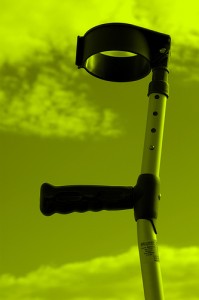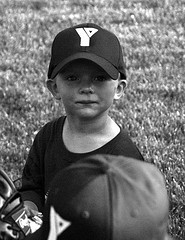 Like most busy parents, if someone had asked me how my family would survive without my constant, direct involvement, I would have shuddered at the mere thought.
Like most busy parents, if someone had asked me how my family would survive without my constant, direct involvement, I would have shuddered at the mere thought.
Impossible, I’d have thought. No carpools? No meal planning, grocery buying, cooking, laundry, sweeping? No one to run to the dry cleaners or bank on the way to or from work? No quick pharmacy stop at lunchtime? Who would rustle the kids out of bed and down to breakfast while my husband walked the dog and made their lunches? Who would trade-off with him for teacher meetings, school performances and piano lessons?
Certain unmitigated disaster.
And yet.
Three months ago, I got off a chairlift and my life took a turn for the worse.
Literally.
After 30 something years of skiing without incident, I managed to zig where I should have zagged. I wasn’t taking chances. I wasn’t speeding or showing off. Just plain bad luck. And like many accidents, this one really wasn’t my fault — the binding on my ski didn’t release as it was supposed to and my body tumbled and twisted while my foot stayed locked into the ski. Ouch.
But as I’ve told my girls many times, it doesn’t matter if an accident is your fault or not – the damage is done.
In spite of this, I feel pretty damned lucky in the grand scheme of things. I managed to sever the anterior cruciate ligament and shred up the cartilage in my right knee, but no bones broke. I didn’t injure my spinal cord or suffer a brain injury or damage an eye. I didn’t have a terrible disease or a degenerative condition. There are a lot of things that even the most talented doctors and skilled surgeons cannot fix. I’ve worked really hard to focus on that kind of gratitude these past few months.
Let’s just say it hasn’t always been easy.
First I had to recover from the initial injury, go to physio and regain some strength and range of motion. Seven weeks later I had surgery to repair the damage. Back to square one. Because my doctor elected to repair my damaged cartilage alongside the ligament, I needed to have my knee immobilized for six straight weeks afterwards. As a super busy working mom of three, being relegated to crutches and prohibited from driving proved extremely difficult.
Formerly the catalyst that got our kids moving and our family organized, I was suddenly totally helpless. Even worse, I needed them to do stuff for me.
I couldn’t make dinner. Or run for the telephone when it rang. Or answer the door. Or walk the dog my kids had begged for but mostly forsaken. Balanced on two crutches, I couldn’t even carry a pitcher of milk from the fridge to the table.
I depended entirely on the extreme kindness of my husband, three daughters, parents, wonderful friends and co-workers. They brought me meals, did my groceries, walked my dog, shlepped my children around. I got lifts to and from work, physio and doctor appointments. They cheered me up with phone calls, text messages and Facebook posts.
I quickly learned what it meant to be handicapped (albeit temporarily). Even the smallest task took planning and enormous effort. For the first time in my life, I knew fear. I was scared to do simple things, like take a shower, or descend the front steps of our house. A sudden snowfall prevented me from leaving home for a day, lest I slip and fall on the ice. I became suddenly aware of the steps up into a store, the lack of elevators in a building, the difficulty of carrying my laptop, purse and lunch to work while on crutches.
All the things I used to do for my family fell to my husband and kids. At least initially, I couldn’t do groceries or laundry, cook or wipe the crumbs off the counter. I didn’t go down to our basement level laundry room for weeks. For a long time, I couldn’t easily get into each of my daughters’ rooms to kiss them good night or lie in their beds chatting in the dark before they drifted off to sleep. All our old patterns, habits and cherished routines fell by the wayside while my body healed itself.
This interruption of their lives made me sadder than anything. I hated not being able to go to them when they needed me. I resented my vulnerabilities. One particularly bad night, after my girls were asleep and my husband was out for a work-related dinner, I lay awake in serious pain with the frightening realization that I had somehow left my medication and the telephones down in the kitchen. I stubbornly refused to wake my kids to help me, but I also didn’t have the strength to safely manage the stairs. I stared at a page in my book for a couple of hours in a fruitless attempt to distract myself until Martin came home.
I like to think I’ll never forget how humbling it was to be helpless. We take our strong bodies for granted. Like all privileges, good health is rarely noticed until it is gone. And when that happens it is truly shocking. Quite the life lesson. Here are some of the other things I’ve learned in these trying couple of months:
My kids can do a heck of a lot more than I thought. Like laundry. And making their own lunches. And putting their own selves to bed. If they unload the dishwasher and put stuff away in different places than I do, that’s not the end of the world. They now set the dinner table, make salads and side dishes. There is less groaning about it than there used to be, because they knew they had to pitch in and help. My challenge is not giving in to the backslide now that I am off my crutches and moving around better. Just because I can do all those things for them again doesn’t mean I should.
I don’t need to be the centre of my family’s universe. Wow, what a profound relief. My girls aren’t preschoolers anymore. They can plan meals and organize their own school uniforms without me. It may not be the food I’d choose, and their shirts may be wrinklier than I’d like, but that’s OK too. The world didn’t explode because my husband bought the wrong kind of milk or heated up frozen pizzas for dinner on consecutive nights. Although feeling so needed clearly struck some deep-seated maternal chord in me, I’ve learned that overly competent, highly controlling parents can undermine their kids’ need to develop some independence.
Our ability to cope with stress is directly related to the support we get. I have some of the most wonderful friends around. I can still count on my mom. Even my father, who is himself physically handicapped and recovering from spinal surgery, was able to help me with lifts around town. All of this brought me to tears at times. I rarely had to ask for anything. The pale outlines of the proverbial village made themselves visible to me in the streets of suburban Montreal. Even as I benefited from all this help, I’ve silently committed to paying all of this forward whenever possible.
We are more fragile than we think. Even when we are in tip-top physical condition, a wrong move, errant cell or careless turn can change everything. But remaining truly appreciative of the health we have is difficult to sustain. I want to remember, but I also know I will forget in time. (I’ve forgotten it before, after all). That taken-for-grantedness is part of the human makeup, perhaps a psychological response to fading novelty.
But I am also keenly aware that some people, like my dad, don’t get better. A temporary handicap is one thing, a permanent one (or a degenerative condition) is quite another. I’ve cultivated a deeper regard for the challenges those kinds of health problems pose for the people who live with them, especially those who are parents of small children and must shift attention from their health problems to the needs of their kids. That is a tremendously difficult thing to do, and they need all of our support. So I hope a part of me never forgets to be thankful for my newly regained ability to go downstairs for my forgotten bottle of pills.
But we are also so much stronger. I never thought I could do this. That my family could do this. I had no idea. With the right kind of support and infrastructure, we can manage way more than we realize. We learn to accept what can’t be changed, to triage, identify the big stuff, make compromises, look to other things for solace and encouragement. I like to think my girls saw us react to a bad situation with humour and level-headed planning (and OK, also some well-timed cursing and the occasional bout of tears).
And though I’m relieved to be on the other side of this (though months of physical rehab are still ahead of me), it’s encouraging to believe my knee was the only thing weakened.



